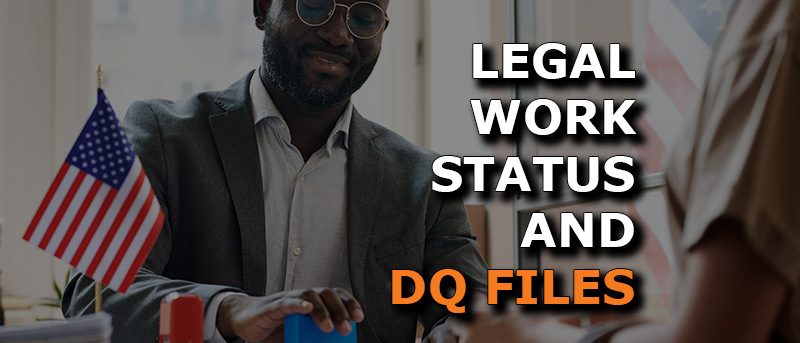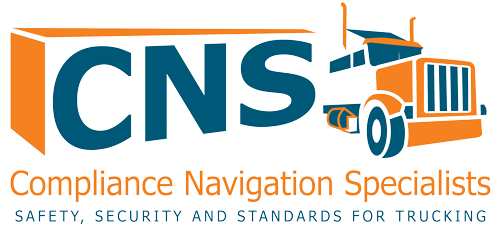Legal Work Status and DQ Files: How to Verify a Driver’s Legal Right to Work in the U.S.

Driver shortages are leading more carriers to consider immigrant CDL applicants—but not all are vetted equally. Learn how to verify work eligibility and document it properly in your DQ Files.
When hiring a new commercial driver, motor carriers must do more than verify driving experience and safety history—they must also confirm that the individual is legally authorized to work in the United States.
Failing to properly verify employment eligibility or document it in the Driver Qualification (DQ) File can expose your company to penalties from both the Department of Transportation (DOT) and the Department of Homeland Security (DHS).
Here’s what every carrier needs to know about verifying a driver’s legal status, the required documentation, and how to properly maintain these records in compliance with DOT and federal employment laws.
Emergency Federal Regulation Tightens Rules for Foreign Commercial Drivers
The FMCSA recently issued an emergency federal regulation introducing strict new eligibility standards for non-domiciled commercial drivers—those who are legally present in the U.S. but are not U.S. citizens or lawful permanent residents.
Non-domiciled CDL applicants must now have lawfully entered the United States under one of a few specific visa programs:
- H-2A: Temporary agricultural workers
- H-2B: Non-agricultural seasonal workers
- E-2: Treaty investors and employees of treaty investors
Drivers who are in the U.S. under other visa types—or pending asylum, parole, or undocumented entry—are no longer eligible for a non-domiciled CDL.
Additionally, there are other strict guidelines for those that qualify:
- States must use federal databases to verify lawful status.
- Licenses will expire after one year with in-person renewals only.
- Employment documentation alone is no longer sufficient proof of eligibility.
NEW TRAINING: English Proficiency Readiness Course is available! – CLICK HERE TO LEARN MORE or SIGN UP!
Step 1: Understand the Legal Requirements
All U.S. employers, including motor carriers, are required by federal law to verify the identity and employment authorization of anyone hired after November 6, 1986.
This requirement comes from the Immigration Reform and Control Act (IRCA) and is enforced by U.S. Citizenship and Immigration Services (USCIS) through the Form I-9 process.
Key takeaway:
Every commercial driver must complete a Form I-9 before starting work, regardless of citizenship or nationality.
Step 2: Special Situations for CDL Applicants Who Are Recent Immigrants
The trucking industry has seen a rise in foreign-born CDL applicants due to ongoing driver shortages. While it’s completely legal to hire non-U.S. citizens who have valid work authorization, carriers must understand the documentation and vetting differences among applicants.
CDL Applicants New to the U.S.
Individuals who recently immigrated to the U.S. may not have three years of prior driving history within the country.
Under 49 CFR §391.23, employers must investigate the driver’s safety performance history for the past three years—but this requirement applies only to employment within the U.S.
If the applicant lived or worked abroad during that time, carriers are not required to obtain foreign driving or employment records. However, you should:
- Document the reason for missing records (“Driver resided outside the U.S. before CDL issuance”).
- Retain a copy of the driver’s CDL, immigration documents, and work authorization.
- Confirm that the applicant meets state-level CDL eligibility requirements, which include lawful presence verification before the CDL is issued.
This ensures that the driver was already vetted at the state licensing level for lawful presence, even if they lack a long domestic driving history.
Don’t Miss Our Ultimate Trucking English Proficiency and Enforcement Guide
Step 3: Understanding Immigration Status and Background Check Gaps
Not all non-citizen applicants undergo the same level of background screening before entering the U.S. or obtaining work authorization.
For example:
- Visa holders (e.g., H-2B, TN, or Green Card holders) typically undergo criminal background checks and vetting before entering the country.
- However, individuals who crossed the border undetected and later surrendered to Border Patrol do not go through the same pre-entry vetting or background checks.
Instead, these individuals are often released into the U.S. pending asylum or immigration proceedings. They may eventually receive temporary work authorization through an Employment Authorization Document (EAD), but carriers should understand that:
- These drivers may not have verifiable prior driving history or background data, either domestically or abroad.
- They are still required to present valid work authorization and identification before being hired.
- Carriers should review all supporting documents carefully, verifying expiration dates and keeping copies in the HR employment eligibility file.
This nuance is critical for maintaining compliance while minimizing operational risk.
Step 4: Complete the Form I-9
The Form I-9, Employment Eligibility Verification, is used to confirm that the driver is legally authorized to work in the U.S.
Employer responsibilities include:
- Ensuring the driver completes Section 1 of the form on or before their first day of employment.
- Reviewing original documents presented by the driver (not photocopies) to verify both identity and employment authorization.
- Completing Section 2 of the form within three business days of the driver’s start date.
- Ensuring the documents appear genuine and relate to the individual presenting them.
Acceptable documents include:
- List A: Documents that prove both identity and work authorization (e.g., U.S. Passport, Permanent Resident Card, Employment Authorization Document).
- List B and C: A combination of documents that prove identity (like a driver’s license) and employment authorization (like a Social Security card).
Important: For commercial drivers, a Commercial Driver’s License (CDL) may serve as a valid List B document (identity), but additional documentation is required from List C or List A to confirm employment eligibility.
Step 5: (Optional) Use E-Verify for Extra Assurance
Many motor carriers voluntarily participate in the E-Verify program—an online system operated by the DHS and Social Security Administration. E-Verify compares information from an employee’s Form I-9 to government databases to confirm eligibility to work in the U.S.
Why use E-Verify?
- Reduces the risk of hiring unauthorized workers.
- Provides additional documentation of compliance.
- Required by law for some federal contractors and in certain states.
While not mandatory nationwide, participating in E-Verify demonstrates a proactive compliance approach and can be beneficial during audits or investigations.
Step 6: Document Properly in the Driver Qualification (DQ) File
The DQ File, required under 49 CFR §391.51, must contain records that show the driver is qualified under DOT regulations. However, the Form I-9 itself should not be placed in the DQ File.
Here’s the correct way to handle this:
- Maintain the Form I-9 and any E-Verify confirmations in a separate confidential file (either electronic or paper).
- In the DQ File, include a note or checklist item verifying that the I-9 process has been completed and is stored separately.
- Never mix I-9 documents with DQ Files to avoid exposing sensitive personal information during DOT audits.
A common best practice is to use a Driver Hiring Checklist that includes items like:
- Copy of driver’s license/CDL
- Medical certificate
- MVR review
- Employment verification
- I-9 verification completed (stored in HR file)
Related: Best Tips for Fleets to Audit Their Driver Qualification Files to Pass a DOT Audit
Step 7: Retain and Update Records as Required
Employers must retain I-9 forms for:
- Three years after the date of hire, or
- One year after employment ends, whichever is later.
If the driver’s employment authorization has an expiration date, you must reverify their eligibility using Section 3 of the I-9 before it expires.
Failure to reverify or update expired work authorization can lead to civil penalties or disqualification findings during a DOT or DHS audit.
Avoid Common Mistakes
Here are frequent compliance issues that carriers should avoid:
- Accepting copies or expired documents for verification.
- Failing to complete the I-9 within three business days.
- Storing I-9s in the DQ File (they must be kept separate).
- Neglecting to reverify non-permanent work authorizations.
- Not training hiring managers on document verification procedures.
How CNS Can Help
At Compliance Navigation Specialists (CNS), we understand that managing employment verification, driver qualification files, and DOT compliance can be overwhelming—especially for growing fleets.
By partnering with CNS, fleets can significantly reduce the administrative burden of managing driver qualification files, allowing you to focus more on operations and less on compliance concerns.
Here’s how:
- Electronic File Storage: CNS securely stores all your driver qualification files electronically, reducing the clutter and inefficiency of paper-based systems.
- Automated Reminders: Receive automated notifications for expiring documents such as medical certificates, CDLs, and MVRs, ensuring timely renewals.
- Easy Access and Organization: CNS provides a centralized platform where you can easily access and organize all driver records, making internal audits straightforward and efficient.
- Compliance Expertise: With CNS’s expertise in DOT regulations, you can trust that your DQ files are maintained accurately and up-to-date with the latest compliance requirements.
- Scalable Solutions: Whether you manage a small fleet or a large multi-state operation, CNS’s services scale to meet your specific needs, providing tailored support to keep your fleet audit-ready.
Learn more about CNS’s Driver File Management Service here.
For more information, contact us at 888.260.9448 or info@cnsprotects.com.
Questions about DOT Compliance, Licensing, Audits, Programs, etc.?
Our DOT Specialists are here to help!
What are you searching for?
Is DOT Compliance your Top Priority?
Our DOT Compliance Programs ensure it is your top priority and keeps your business running.
Related Services
Subscribe to our Monthly Newsletter
Receive the latest transportation and trucking industry information about FMCSA and DOT Audits, Regulations, etc.
Related news
Trucking News
Get the latest trucking news on DOT Compliance, Licensing, Audits, and more!

Pennsylvania’s Non-Domiciled CDL Program is Changing: What Happened, What Comes Next, and What Carriers Should Expect
Pennsylvania’s entire non-domiciled CDL system is heading for a major overhaul that is being pushed by federal pressure, public safety concerns, and politics. Here’s what

The 10 Most Common DQF Violations (And How to Avoid Them)
Every year, DOT auditors uncover thousands of violations related to Driver Qualification Files (DQFs). For many carriers, these mistakes can trigger hefty fines, audit failures,

Clearing the Confusion: What a “Driver CSA Score” Really Means
In the trucking world, safety scores are everything. Whether it’s insurance rates, hiring decisions, or DOT inspections, people want to know if a driver is
